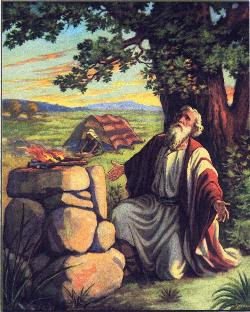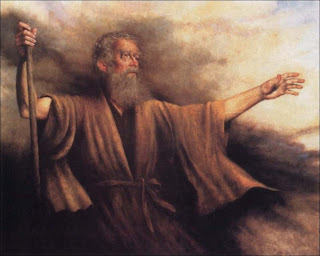
Abraham 1; Facsimile 1 – to be discussed January 7
Day 1: Read (review) Abraham 1:1-4; D&C 132:28-32
1. How did Abraham find greater happiness, peace and rest?
2. What made Abraham a “rightful heir”?
3. Read D&C 132:28-32. How did Abraham receive all things?
Day 2: Read Abraham 1:5-11
4. Using Abraham 1:5, from what two things did Abraham say his fathers had turned?
5. List what Abraham’s fathers’ hearts had turned to.
6. For what reason were the three daughters of Onitah sacrificed on the altar?
BONUS: Review Moses 5:5-7. What was the human sacrifice made by the false priests a corruption or counterfeit of?
Day 3: Read Abraham 1:12-15, 30
7. According to Abraham 1:30, who might one of the idolatrous priests have been, who sought to kill Abraham?
8. Why do you think the false priests wanted Abraham dead? (See again Abraham 1:4-6.)
9. What did Abraham do as he lay on the altar expecting he would die? With what was he filled? Who stood by him?
Day 4: Study Facsimile 1; read Bible Dictionary entry, “Angels”
10. Look at figures 5, 6, 7, and 8, representing various idolatrous gods. If you had to guess, what might each head resemble?
11. How is “The Angel of the Lord” depicted in Facsimile 1? Read the Bible Dictionary entry, “Angels,” paragraphs one and two. What kind of a being might Abraham’s angel have been?
12. What does the representation of the idolatrous god of Pharaoh (figure 9) look like? In what is he “swimming”?
Day 5: Read Abraham 1:16-19
13. Read Abraham 1:16 with footnote a. Whether the angel addressed Abraham as “Abram” or
“Abraham,” he clearly spoke for (or actually was) Jehovah, and came in answer to Abraham’s prayer. Why was Abraham delivered from death?
14. Why did the Lord promise to “visit” the idolatrous nation? Was this a good visit?
15. List promises the Lord made to Abraham.
Day 6: Read Abraham 1:20-25
16. Why did the Lord destroy the altar on Potiphar’s Hill?
17. From whom were the Pharaohs of Egypt descended? Did they have legitimate claim to the priesthood of God? Why or why not?
18. Who first settled the land of Egypt? What kind of government did the Egyptians practice?
Day 7: Read Abraham 1:26-31
19. What did the pharaohs embrace instead of the true priesthood?
20. How did the famine in Chaldea affect Abraham’s family?
21. What kinds of records did Abraham possess?










